Influence of the Magnetite Nanoparticles on Dielectric Properties of Nanocomposites on the Basis of Linear Polyethylene of Low Density-Juniper Publishers
Authored
by Novikov GF
The nanocomposite of magnetite/linear low-density polyethylene has been synthesized. Influence of magnetite nanoparticles in concentration 1-20wt% on dielectric properties and conductivity of nanocomposites in the range of frequencies 10-2-105Hz and temperatures from 113 to 383K have been studied. Inclusion of particles of magnetite in polyethylene slightly changed melting temperature. But at the same time an imaginary part of complex dielectric permittivity increased sharply (on two orders of size) and enthalpy of fusion decreased by 25J/g.
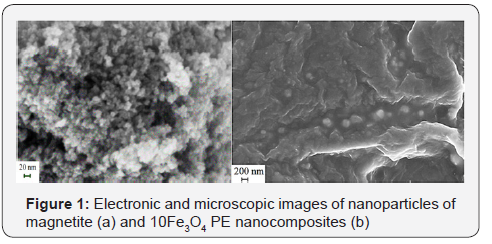
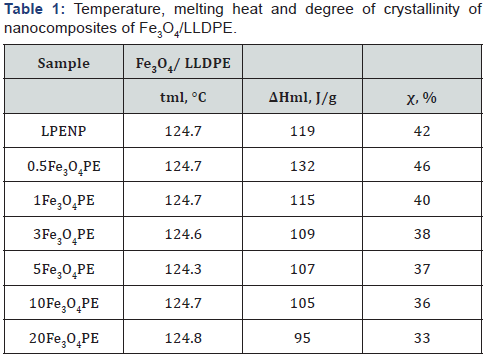

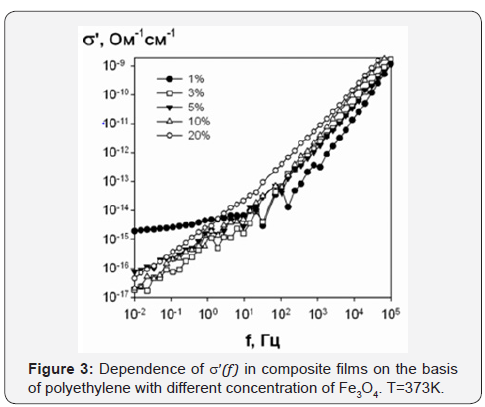
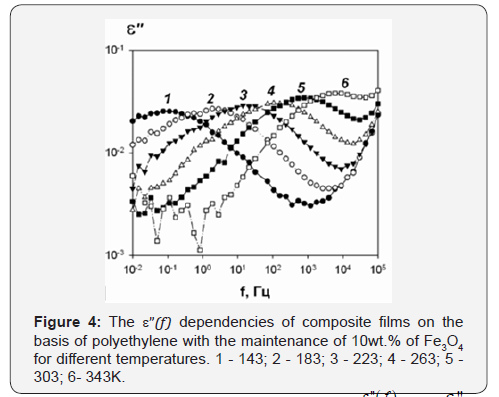
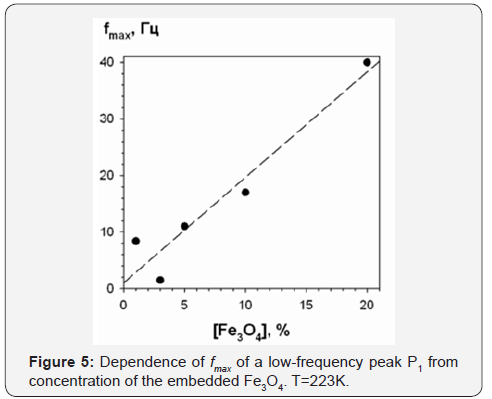
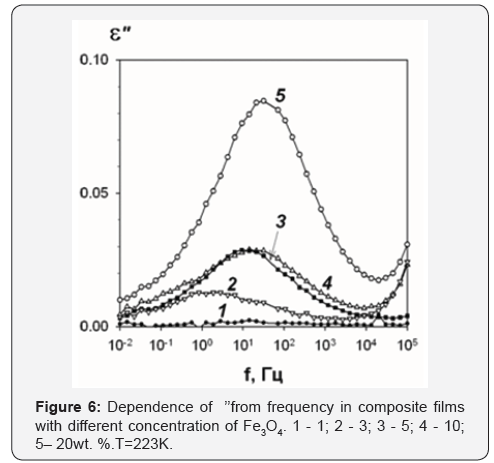
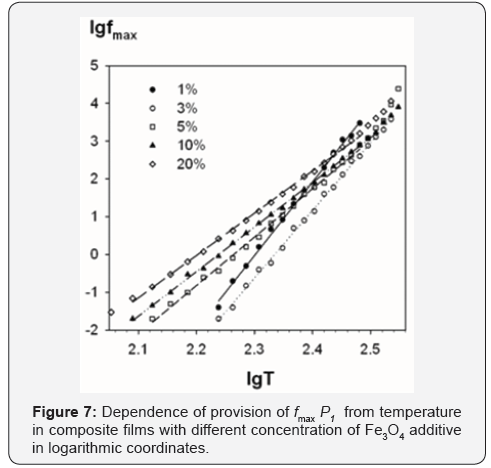
The nanocomposite of magnetite/linear low-density polyethylene has been synthesized. Influence of magnetite nanoparticles in concentration 1-20wt% on dielectric properties and conductivity of nanocomposites in the range of frequencies 10-2-105Hz and temperatures from 113 to 383K have been studied. Inclusion of particles of magnetite in polyethylene slightly changed melting temperature. But at the same time an imaginary part of complex dielectric permittivity increased sharply (on two orders of size) and enthalpy of fusion decreased by 25J/g.
Keywords: Linear low-density polyethylene; Magnetite; Dielectric properties; Electrical conductance
Introduction
Development of polymeric composition materials is one
of the priority directions of development of modern technologies and
the equipment. A unique combination of valuable properties of polymeric
matriсes such as film formation, mechanical strength, chemo-and
corrosion resistance, on the one hand, and functional properties of
nanodimensional fillers, -with another hand, allows to consider such
materials as perspective for use in aerospace technology, instrument
making, microelectronics, medicine and other hi-tech fields of the
industry [1].
The main engine of development of consumption of the
composition materials (CM) is resource-saving: weight reduction,
increase in productivity, cost cutting. Among composition materials of
different function special attention is paid to materials on the basis
of polyolefins. They attract with technological effectiveness, small
specific weight and low cost. Development highly effective thermo
flexible CM, containing different functional nanofillers and processed
into products by means of high-performance technologies, is a relevant
scientific and technical task. For receiving metal-polymeric
nanocomposite materials various approaches are developed. Among them
methods of dispergating of metallic nanoparticles or their formation
directly in a polymeric matrix and also the synthesis of nanocomposites
consisting in simultaneous formation of the high-dispersed particles and
the stabilizing polymeric matrix were widely adopted.
Different types of polyethylene (PE), for example,
were used as a polymeric matrix for TiO2 and TiO2/Ag nanoparticles
[2,3], Cu [4]. For example, copper nanoparticles with different contents
from 1 to 3wt% were synthesized by in situ thermal decomposition of the
precursor in the melt of PE. The diffraction patterns of the
nanocomposites obtained have peaks of both LLDPE ( 21.65; 23.95; 30.10;
36.3; 40.75; 42.95°), and copper nanoparticles ( 43.40; 50.45 and
74.15°). Copper nanoparticles, produced in the PE melt have dimensions
of 20-30nm with a narrower size distribution. The received hybrid
materials showed improvement of mechanical, thermal and barrier
properties. The modified MgO nanoparticles (3wt%) in a matrix of linear
polyethylene of low density (LLDPE) had significant effect on DC
conductivity of polymer, reducing it honor by 100 times [5] that is
explained that the surface of nanoparticles can actively connect polar
molecules, ions, charges of particles though, in general, the nature of
such influence remains until the end of not clear.
The purpose of the real work is studying of influence
of magnetite nanoparticles on dielectric properties of nano composites
on the basis of linear polyethylene of low density.
Experimental Part
Receiving magnetite
The solution of FeCl3*6H2O and FeCl2*4H2O crystalline
hydrates in water was prepared at molar ratio 2:1. The concentrated
NH4OH was added to solution at 40 °C at intensive
stirring within 10-15min. Reaction mixture was kept by 30 min.
The formed precipitate of black color was washed out in water
before neutral reaction, separated by means of a static magnet
or centrifuging within 15 min., washed out in addition with ethyl
alcohol and stored in dry benzene.
Receiving nanocomposites
The LLDPE -Fe3O4 nanocomposites with filler content of
0.5-20wt. % were received by mixing of LLDPE and filler with
use of an extruder of HAAKE of Minilab of the Rheomex CTW5
type with synchronous rotation of two conic screws in the argon
atmosphere. Extruding temperature was 150 °C, screw speed
was 60RPM, and duration of material loading was 20 RPM. Time
of hashing was of 10-20min. Film samples of nanocomposites
received by method of hot pressing with use of the manual
electro warmed hydraulic press.
X-ray phase analysis
The analysis was carried out on the x-ray powder
diffractometer“DRON-UM-2”. The size of particles was calculated
on the basis of line broadening in a range on Sherrer’s equation:
d = Kλ / (β cosθ ) , where d-the average size of domains
(crystallites); K-the dimensionless coefficient of a form of
particles (Sherrer constant a) making ~0.9; β-reflex width (on a
half of the maximum intensity); λ-the wavelength of x-ray
radiation; θ-the angle of diffraction.
Electronic and microscopic researches
Electronic and microscopic researches were conducted by
means of the scanning auto emission electron microscope of
“Zeiss SUPRA 25”. X-ray spectral energy dispersive analysis of
samples was carried out on the INCA Energy prefix to a scanning
electron microscope of “Zeiss SUPRA 25” at an acceleration
voltage of 9kW. IR spectra are registered on tablets with KBr on
the Specord-M80 spectrophotometer of Carl Zeiss (Germany)
equipped with the Soft spectra program. DSC analysis of
composites carried out with using the Mettler DSC 30 device at a
speed of heating of 10hails/min.
Dielectric measurements
Dielectric measurements were taken in frequency band
f =10−2 −105Hz and temperatures from 113 to 383 °C with using
“A broadband dielectric spectrometer” of Novo control GMBH.
Sample temperature during measurements was controlled about
accuracy 0.5 °C. The measuring cell consisted of two electrodes
from stainless steel. Diameter of electrodes is 20mm. Tension
between electrodes did not exceed 1V.
Results and Discussion
Synthesis, morphology and microstructure of Fe3O4/ LLDPE nanocomposites
The magnetite nanoparticles were obtained by chemical
reaction of aqueous solutions of iron (II) and (III) chlorides
in the presence of alkali in argon. Data of the element analysis
(found/calculated, %) are: Fe - 71, 89/72, 36; O - 27, 82/27, 64;
IR, , см-1: 580, 640 (Fe-O), 1580-1481, 935-830 (OH).
The structure, morphology and microstructure of the
received nanocomposition materials are investigated by the X-ray
methods and electronic microscopy. Filler nanoparticles during
dispersion are rather evenly distributed in volume of a matrix,
both particles of the initial sizes, and their conglomerates are
observed (Figure 1), what is confirmed by also widened peaks
on the x-ray diffractograms corresponding to a nanofiller phase.



Systematic reduction of an enthalpy of melting ΔН is
established at increase in maintenance of nanoparticles of magnetite in a polymeric matrix of LLDPE (Table 1). The similar
filler content dependence is characteristic for the degree of
crystallinity of nanocomposites calculated by a formula χ.=Nv/
N100*100% where Nv.- the heat which is marked out during the
melting of a sample, H100- the heat which is marked out when
melting 100% of crystal polymer for LLDPE of N100 = 285J/g [6]
(Figure 2).
Dielectric properties of the Fe3O4/ LLDPE nanocomposites
The dependences of real parts of complex electrical
conductance of / //
0 s * = je we* =s + js on frequency in composite
films on the basis of polyethylene with different concentration of
Fe3O4 measured at a temperature of 373 K are shown in Figure 3.

It can be seen that the plot log(s / ) =ϕ (log( f )) for films of the
containing 1wt. % of Fe3O4 has two components. In highfrequency
band conductivity depends on frequency. In low
frequency band conductivity does not depend on frequency. It is
natural to carry the expressed plateau in the low frequencies
band which extends to the area of high frequencies with growth
of temperature to transport of free charges [7] - dc-conductivity.
Transition from area of the plateau to a high-frequency part
of dependence of ac-conductivity, ( ) ’
ac s f , corresponds to change
of the mechanism of electrical conductance. Area of the plateau
in the left part of dependence log(s / ) =ϕ (log( f )) reflects the
movement of charges on long distances. In the right part of
increases with increase in frequency, and the movement of
charges is limited to space of their potential holes. Let’s notice
that in both cases the derivative for time of the total electric
dipolar moment is responsible for emergence of current in an
external circuit. It can be seen from the Figure 3 that the change
of the mechanism of electrical conductance is observed at lower
frequencies f* at increase in concentration of the embedded
Fe3O4.

On (Figure 4) the dependence of imaginary e ''( f ) part, e '' , of
complex dielectric permittivity e *=e '− je '' on frequency in
composite films with the maintenance of 10wt.% of Fe3O4 for
different temperatures. It can be seen from the drawing that two
picas are observed on the dependence e ''( f ) : low-frequency
peaks ( 4 )
1 10 max P − f < H and high-frequency one ( 4 )
2 – 10 max P f > Hz .
The peak P1 is displaced towards higher frequencies with
growth of temperature. While the peak P2 (which appeared on
the edge of the frequency range) of the device does not depend
on measurement temperature.
The dependence of imaginary e '' of complex dielectric
permittivity on frequency in composite films with different
concentration of Fe3O4 measured at a temperature of 223K is
provided in Figure 5. It is seen from the drawing that not only
increase in amplitude of the peak P1, but also shift on frequency
is observed at increase in concentration of the embedded Fe3O4.

The dependence of a low-frequency peak P1 from
concentration of the embedded Fe3O4 at temperature of 223K is
shown in Figure 6.


The dependences of max f of the peak P1 on measurement
temperature for different structure of a composite are shown in
(Figure 7) in logarithmic coordinates. The provided results
indicate an essential contribution of percolation to properties of
a composite. However, data (Figure 7) demonstrate unusually
strong power characteristic of provision of frequency of
maximum P1 on temperature that demands the additional
analysis.
We are going to carry out the detailed theoretic analysis of
influence of nanoparticles of magnetite on dielectric properties
of nanocomposites on the basis of linear polyethylene of low
density in the following unrolled publication.
Acknowledgment
The work was performed within the frameworks of Projects
No. 01201055328 and No.0089-2014-0036).
For more
details Academic Journal of Polymer Science please click on: https://juniperpublishers.com/ajop/index.php
To read more…Full Text in Juniper Publishers click on https://juniperpublishers.com/ajop/AJOP.MS.ID.555552.php

Comments
Post a Comment